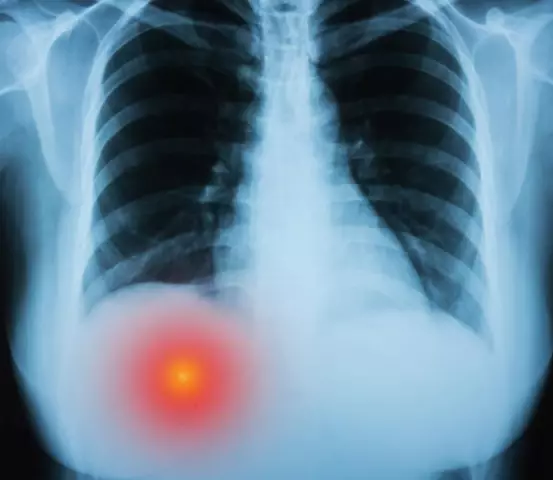- Author Rachel Wainwright [email protected].
- Public 2023-12-15 07:39.
- Last modified 2025-11-02 20:14.
Right ventricle
The right ventricle is the chamber of the human heart, in which the small circle of blood circulation begins. There are four chambers in the heart. In the right ventricle, venous blood enters from the right atrium at the time of diastole through the tricuspid valve and is pumped at the time of systole through the pulmonary valve into the pulmonary trunk.

The structure of the right ventricle
The right ventricle is bounded from the left posterior and anterior interventricular grooves on the surface of the heart. It is separated from the right atrium by a coronal sulcus. The outer edge of the ventricle has a pointed shape and is called the right edge. In shape, the ventricle resembles an irregular trihedral pyramid, with the base directed up and to the right, and the top - left and down.
The posterior wall of the ventricle is flat, and the anterior wall is convex. The inner left wall is the interventricular septum, it has a convex shape (convex towards the right ventricle).
If you look at the right ventricle in section at the level of the apex of the heart, it looks like a slit, elongated in the anteroposterior direction. And if you look at the border of the middle and upper third of the heart, then it resembles the shape of a triangle, the base of which is the septum between the ventricles, protruding into the cavity of the right one.
In the cavity of the ventricle there are two sections: the posterior wide and the anterior narrower. The anterior section is called the arterial cone, it has an opening through which it connects to the pulmonary trunk. The posterior section communicates with the right atrium using the right atrioventricular opening.
On the inner surface of the posterior region, there are many muscle bars that form a dense network.
Around the circumference of the atrioventricular opening, the right atrioventricular valve is attached, which does not allow the backflow of blood from the ventricle to the right atrium.
The valve is formed by three triangular flaps: front, back and septal. All cusps protrude as free edges into the ventricular cavity.
The septal flap is located closer to the ventricular septum and is attached to the medial part of the atrioventricular opening. The anterior flap is attached to the anterior part of the medial foramen, it faces the arterial cone. The posterior valve is attached to the posterior-external part of the medial foramen. Often a small additional tooth can be seen between the posterior and septal leaflets.
The opening of the pulmonary trunk is located on the left and anterior and leads to the pulmonary trunk. Three flaps can be seen around the edges of the hole: front, left and right. Their free edges protrude into the pulmonary trunk and together they form the pulmonary valve.
Diseases associated with the right ventricle
The most common diseases of the right ventricle are:
- Pulmonary stenosis;
- Right ventricular hypertrophy;
- Right ventricular infarction;
- Right ventricular block.
Pulmonary stenosis
Stenosis is an isolated narrowing of the pulmonary artery. The narrowing of the outlet to the pulmonary artery can be located at various levels:
- Subvalvular stenosis of the pulmonary artery is formed as a result of the proliferation of fibrous and muscle tissue in the infundibular part of the ventricle.
- Stenosis of the annulus fibrosus forms at the junction of the right ventricular myocardium into the pulmonary trunk.
- Isolated valvular stenosis is the most common heart disease (about 9% of congenital heart defects). With this defect, the pulmonary artery valve is a diaphragm with an opening with a diameter equal to from 2 to 10 mm. The division into valves is often absent, the commissures are smoothed.
With stenosis of the pulmonary trunk, the pressure in the right ventricle increases, which increases the load on it. As a result, this leads to an increase in the right ventricle.
Right ventricular hypertrophy
In fact, right ventricular hypertrophy is not a disease, but rather a syndrome that indicates an increase in the myocardium and causes a number of serious diseases.
The enlargement of the right ventricle is associated with the growth of cardiomyocytes. As a rule, this condition is a pathology and is combined with other cardiovascular diseases.
Enlargement of the right ventricle is quite rare and is often diagnosed in patients with diseases such as pneumonia and chronic bronchitis, pulmonary fibrosis and emphysema, pneumosclerosis, bronchial asthma. As mentioned above, right ventricular hypertrophy can be caused by stenosis or congenital heart disease.
The normal mass of the right ventricle is about three times less than that of the left. It is with this that the predominance of the electrical activity of the left ventricle in a healthy heart is associated. Against this background, right ventricular hypertrophy is much more difficult to identify on an electrocardiogram.
Based on the degree of enlargement of the right ventricle, the following types of hypertrophy are distinguished:
- Severe hypertrophy - when the mass of the right ventricle exceeds the left;
- Average hypertrophy - the left ventricle is larger than the right one, however, in the right one there are processes of excitation associated with its increase;
- Moderate hypertrophy - the mass of the left ventricle is much larger than the right one, although the right one is slightly enlarged.
Right ventricular infarction
In about 30% of patients with inferior infarction, the right ventricle is affected to some extent. Isolated right ventricular infarction occurs much less frequently. Often, an extensive infarction leads to severe right ventricular failure, in which there is a Kussmaul symptom, swelling of the cervical veins, and hepatomegaly. Arterial hypotension is possible. On the first day, there is often an increase in the ST segment in the additional chest leads.
The extent of the right ventricular lesion can be detected by echocardiogram.
Right ventricular block
Right ventricular block occurs in about 0.6-0.4% of healthy people. The prognosis of this disease depends on the heart disease. For example, with an isolated blockade, the prognosis is quite favorable, since there is no tendency to develop coronary heart disease.
Right ventricular block can develop as a result of pulmonary embolism or anterior infarction. If the blockage occurs as a result of a heart attack, the prognosis is negative, since heart failure and sudden death often occur in the first months.
A blockage resulting from a pulmonary embolism is usually transient and occurs predominantly in patients with severe pulmonary artery disease.
Found a mistake in the text? Select it and press Ctrl + Enter.






